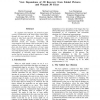Free Online Productivity Tools
i2Speak
i2Symbol
i2OCR
iTex2Img
iWeb2Print
iWeb2Shot
i2Type
iPdf2Split
iPdf2Merge
i2Bopomofo
i2Arabic
i2Style
i2Image
i2PDF
iLatex2Rtf
Sci2ools
3DPVT
2004
IEEE
2004
IEEE
View Dependence of 3D Recovery from Folded Pictures and Warped 3D Faces
In a popular visual illusion, the portrait on paper currency is folded into an M shape along vertical lines through the nose and the eyes. When this folded picture is tilted back and forth horizontally the face undergoes striking changes in expression. This distortion reveals two insights concerning 3D representation in the human visual system and we have explored these with experiments on simple schematic faces and observations on distortions of laser range images of faces. The observations show first that when recovering depicted depth, pictorial cues are interpreted independently of binocular depth information and second, that the recovery of facial expression is based on a scaled prototypical face structure.
3DPVT 2004 | Popular Visual Illusion | Scaled Prototypical Face | Simple Schematic Faces | Visualization |
| Added | 20 Aug 2010 |
| Updated | 20 Aug 2010 |
| Type | Conference |
| Year | 2004 |
| Where | 3DPVT |
| Authors | J. Patrick Cavanagh, Michael von Grünau, Lee Zimmerman |
Comments (0)

